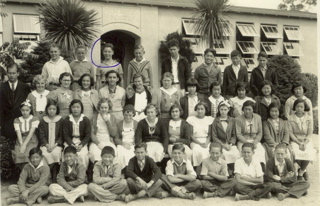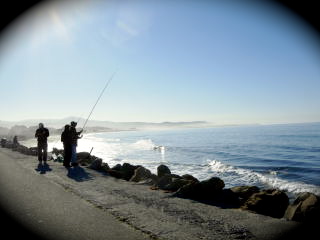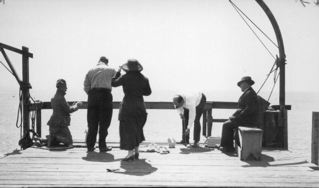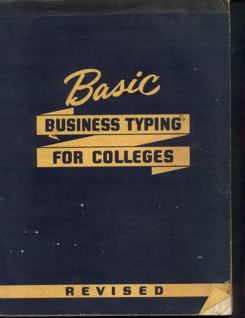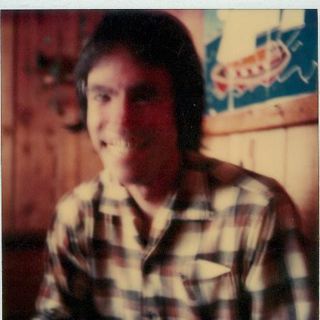It Took A Long Time For The South Coast To Get Electricity: Part I
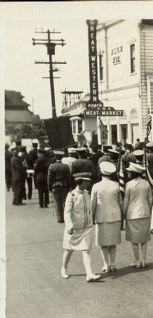 (Photo: Great Western building on Main St, Half Moon Bay, at right. In the foreground, a parade.)
(Photo: Great Western building on Main St, Half Moon Bay, at right. In the foreground, a parade.)
By 1925 much of the Bay Area had been electrified–but there was no electricity to light the darkness south of Half Moon Bay.
As the sun dimmed and the shadows took hold of the night, San Gregorio and Pescadero were stilled. An occasional flash of light from the headlights of a speeding rum-running automobile ws the only break in the night. Farmers and housewives depended on coal oil lamps for the routine tasks of living.
With an office on Main Street in Half Moon Bay, the northern Coastside was served by the Great Western Power Co. (GWPC) of California.
“Nowadays a good continuous supply of electric power is as necessary in the home and in the kitchen as it is in the artichoke field,” the Half Moon Bay Review proclaimed in 1923.
GWPC was committed to the spread of electrification, as was its powerful arch-rival, Pacific Gas & Electric Co. PG&E kept an office in Redwood City but it was known on the coastside for its aggressive ads in the Review.
In the early 1920s many rival power companies were elbowing for business room in California. It wasn’t extraordinary for two different power companies to light the opposite sides of a street in the same town.
The struggle to electrify the south Coast was just part of a larger competition between PG&E and GWPC. Great Western had long served the Coastside–and in early 1925 asked the County Board of Supervisors to grant it a franchise to expand power lines. The request was denied.
In late June 1925 having been denied the franchise, Great Western had no choice but to enter into a race with PG&E.Which company would plant power poles fast enough to reach electricity-starved Pescadero first?
The prize could guarantee supremacy on the Coastside.
…To be continued…
At the Reno airport, I was surprised to see that I could buy a new IPOD in a glass case that might have held candy bars.
Besides IPODS and slot machines at the airport, there was also a black massage chair ($1 for 3 minutes) and I tried it. I’m not sure I’d do it again–the mechanical “hands” felt like they were made out of steel and they were an x-tra large size…every few seconds the stiff steel hands would move to another part of my back….I think the massage chair needs re-working, good idea though.
I Finished The New Grisham Book
I’ve  read the first 100 pages of the new John Grisham book (The Innocent Man) and it’s riveting. There are some repetitions of information that bug me but I’m thoroughly enjoying it.
read the first 100 pages of the new John Grisham book (The Innocent Man) and it’s riveting. There are some repetitions of information that bug me but I’m thoroughly enjoying it.
Update, Update:
Finished the book highlighting major miscarriage of justice in Oklahoma–Couldn’t put it down ’til I got to the last page…Grisham’s version–IN REVERSE–of Truman Capote’s “In Cold Blood”–my opinion..
Fishing At El Granada
Another Time: Princeton Pier
On Writing Poetry By Anonymous
“…Sometimes, writing poetry is frighteningly easy. Those are the times when the whole thought is
compact enough that you can get it out in virtually one sitting.
“The hard part is when your inspiration has only given you a fragment
of the content, and you have to fill the rest by using recollection,
common sense, logic and, actually, writing. It’s those fragments that
fill the dry corners of the basement, year after year. I once had a
fairly long poem pour out of me complete on a quiet Saturday morning
when no one was around. That one is down in the basement, too, and
I’m thinking of trying to find it…”
How I Learned To Type
Master Builder Paul James
1974: Remembering “Mr. Ed” & His $3 Million Plan To Help Develop The Coastside

Mr. Ed called a “Community Meeting” on February 26, 1974—was it held in the offices of a colorful dentist, now long gone?
Ed was a husky fellow with long hair hanging like a crown of feathers from his head. In the center of the crown was a neat, clean bald spot. He was always good natured.
In the early 1970s there were different layers of Coastsiders– the locals who had lived here all their lives and the newcomers who could be broken down into sub-groups of environmentalists, seclusion-lovers and hippies.
The Coastside was a temporary haven for the hippies.They had their eye on a place that was most often simply identified as “up north”–was it Said Valley? Some of them had already left Half Moon Bay and made a new home there.
It was the “growth” that was was pushing the Coastside hippies away– the appearance of the Alpha Beta supermarket for starters–they knew the very first traffic lights couldn’t be far behind.
The Coastsider hippies I encountered were mostly family-oriented, working hippies–woodworking and cutting down trees and selling slabs of pretty redwood burls for tables.
Within the hippie group, Mr. Ed held a special position not only because he was very smart– but he also said he had “visions”. One time, for example, he was watching the sun set when before his eyes it changed from a big orange ball of fire into a pyramid–for some folks a powerful and magical shape.
In 1974 Mr. Ed sensed hard times coming–President Nixon was facing certain impeachment–and Ed feared a financial depression. He said the Coastside hippies needed to be organized work-wise, moving their logs and wood products efficiently to the point of sale– and he was the one to do it.
Thus the “Community Meeting” was called in the dentist’s office.
Mr. Ed brought together the creme de la creme of Coastside hippies. His main goal, he said, should times get tough, was to ensure that the communal- loving hippies had plenty of work. He proposed a $3 million project–a new trucking enterprise that would involve driving “up north” to pick up shingles from the former Coastsiders who had relocated and bringing the wood products back to Half Moon Bay for sale.
At the time there was no construction going on “up north” and the hippies who had moved there from Half Moon Bay were in dire straits. There was some building on the Coastside, but on the sidelines, just waiting for the green light,were plenty of heavy-hitters, pocket books open, ready to fill in the beautiful open space with houses and subdivisions. And that was what Mr. Ed believed would make his project turn into gold at the end of the rainbow.
Communal as they might have aspired to be, the Coastside hippies resisted organization. They admired Mr. Ed’s plan and considered it–but the timing was all wrong. The hippies and the small builders and the heavy hitters were all thwarted by a big, successful “Save the Coastside” campaign–which ultimately resulted in no building at all.
And then the first signal light was put in–by then the Coastside hippies had moved to the mysterious “up north”…”Mr. Ed” vanished and there were no more flyers on the front door announcing “Community Meetings”.
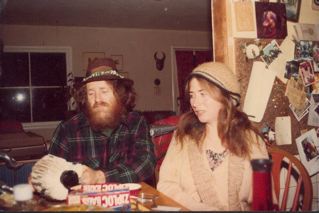 Photo: Dino, (left), seen here with his friend Elizabeth, was one of the “hippies” who attended Mr. Ed’s Community Meeting in 1974.
Photo: Dino, (left), seen here with his friend Elizabeth, was one of the “hippies” who attended Mr. Ed’s Community Meeting in 1974.

